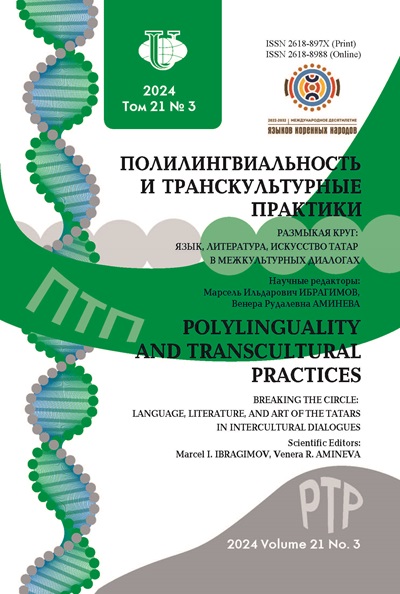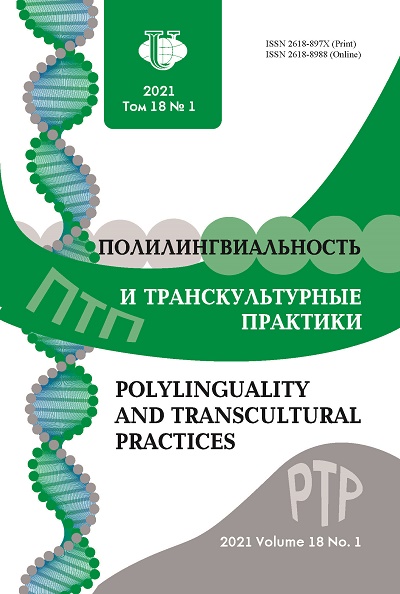Том 18, № 1 (2021)
- Год: 2021
- Статей: 10
- URL: https://journals.rudn.ru/polylinguality/issue/view/1412
- DOI: https://doi.org/10.22363/2618-897X-2021-18-1
Весь выпуск
Языковые контакты
Всеязычные устремления: на примере Всеобщей декларации прав человека
Аннотация
 6-19
6-19


Русский язык в Казахстане: особенности обучения и функционирования в контексте межъязыкового взаимодействия
Аннотация
Многообразие и специфика культур и языков этносов, проживающих на территории Казахстана, создают особый социокультурный контекст евразийского пространства, демонстрируя модель современного межэтнического языкового и социокультурного взаимодействия. Своеобразие социально-коммуникативного пространства страны, характеризующееся доминированием государственного казахского и русского языков - языков двух крупных этнических групп - на фоне большого языкового разнообразия, определяет значимость изучения их взаимодействия и взаимовлияния в контексте мультикультурного общества. В статье анализируются вопросы языкового взаимодействия в полиэтническом государстве, формы и методы воздействия иностранного языка на русский язык. Рассмотрены вопросы изучения и функционирования русского языка как родного и как второго. Активные процессы, обусловленные особенностями взаимодействия казахского и русского языков, анализируются как речевая деятельность этнических русских; русская речь других этносов; изучение и использование русского языка репатриантами-казахами и иностранными гражданами.
 20-28
20-28


Художественное измерение
Транскультурность и ее проявление в поэтике лирических текстов
Аннотация
В статье на примере творчества русского советского поэта Павла Николаевича Васильева показана репрезентация транскультурной эстетики в художественном тексте, созданном на русском языке русским автором, сформировавшимся в условиях «пограничного» сосуществования двух культур - русской и казахской. Его произведения можно отнести к «литературе пограничья», в которой сочетание русскоязычного дискурса и парадигмы степной, кочевой культуры порождает гибридный текст, обладающий своеобразной художественной эстетикой и поэтикой, которая прослеживается на внешнетекстовом и внутритекстовом глубинном уровне. «Я» автора с «пограничным» мышлением обладает стабильной этнической идентичностью, открыто проявляя при этом свою бикультурную принадлежность, что вполне согласуется с тезисом о гибкости и подвижности культурной идентичности транскультурного поэта или писателя. На внешнетекстовом уровне художественных произведений транскультурность находит выражение в тематике, в экзотизмах, в иноязычных вкраплениях и вставках. Транскультурная сущность авторского сознания порождает гибридные тексты, содержащие симбиотические словесные образы и приемы, демонстрирующие гибридные каноны и символы (символы полыни, коня), вбирающие в себя элементы казахских и русских культурных стереотипов и кодов (стереотипные представления об азиатской внешности казахов), которые неконфликтно сосуществуют в художественной картине мира Васильева. В результате возникает уникальная в эстетическом плане поэтическая картина мира, обогащенная парадигмами двух различающихся культур, которая является достоянием русского культурного пространства.
 29-43
29-43


Среднеазиатские социальные типажи как паттерн ориентализма в прозе Леонида Соловьёва
Аннотация
Творчество русского писателя Леонида Васильевича Соловьёва (1906-1962) было широко известно в советский период ХХ века - но только романной дилогией о Ходже Насреддине. Прочие его рассказы и очерки не входили ни в репертуар читателей, ни в фокус исследователей. Одна из причин - писатель попал под репрессивный каток сталинского режима за якобы антисоветскую деятельность. В свете современных посториенталистских штудий проза Соловьёва приобретает свою актуальность как один из фрагментов русского ориентализма в целом, в частности его советского извода. Цикл «Восточных рассказов», ставший материалом статьи, никогда прежде не был объектом научного исследования. Авторы статьи в широком плане заняты выявлением особенностей ориентальной поэтики Соловьёва, в узком - некоторыми паттернами среднеазиатской картины мира, в частности, в статье представлены портреты социальных и профессиональных типов Средней Азии, которых Соловьёв встретил в 1920-1930 годы. Одни из них канули в историю, других можно встретить и сегодня, в XXI веке. В междисциплинарном контексте статьи использованы сравнительный, типологический и культурологический методы.
 44-59
44-59


Арсенал
Глоссарий по литературе российских немцев
Аннотация
В статье представлены материалы к авторскому глоссарию (словарю) по литературе российских немцев (авторские определения литературоведческих понятий, связанных с литературой российских немцев, сделанные на основе ее изучения в докторской диссертации и ряде статей). Писатели - российские немцы - русско-немецкие билингвы, поэтому словарь по литературе российских немцев должен быть представлен в немецко-русском формате (статьи на немецком и русском языках). В самобытной литературе российских немцев есть явления и факты, специфичные именно для этой субкультуры. Словарь по литературе российских немцев, поясняя значения слов, которые могут быть незнакомы, непонятны или частично непонятны читателю, позволяет значительно расширить круг ценителей литературы российских немцев, облегчает восприятие художественного и научного текста.
 60-66
60-66


Интервью
«В поисках собеседника»: интервью с Бахытом Каирбековым. Часть первая, или Ипостась главная. Поэт
 67-79
67-79


«В поисках собеседника»: интервью с Бахытом Каирбековым. Часть вторая, или Ипостась другая. Переводчик
 80-90
80-90


Персоналии
 91-102
91-102


Рецензии
«Код слова» О.О. Сулейменова в электронно-рукописном и полиграфически изданном вариантах
Аннотация
В рецензии осуществлен сравнительный анализ электронной рукописи и полиграфически изданной книги О.О. Сулейменова «Код слова. Введение в Универсальный этимологический словарь “1001 слово”». Рассмотрены сходства и различия в семантико-стилистических выдвижениях заглавий и параграфов в электронно-рукописном и полиграфически изданном оригинале. Выявлены и проанализированы структурные и качественные различия в содержании новых вариантов заглавий книги, особенности смыслового выдвижения в них, вбирающих в себя краткое отражение содержания соответствующего раздела исследования. Осуществлен анализ и тезисное описание новых параграфов, которые были введены автором после работы над электронной рукописью книги. Главным концептуальным подходом О.О. Сулейменова к изысканию древнего первоисточника слова (этимона) и письма как в рукописи, так и в оригинале книги является рассмотрение в единстве, в тесной взаимосвязи основных пяти аспектов научной проблемы: образное изображение (рисунок, иероглиф), понятие, слово, значение, произношение языковой единицы в языках, наречиях, диалектах, говорах в древности и в настоящее время, их смысловые и звуковые сходства и различия в разных регионах земли. Эволюция формулировок заглавий и семантико-стилистического выдвижения в них существенная, что связано или с незначительным лексическим изменением формулировки названия параграфа, или с введением другого (обновленного) заглавия, или с введением в структуру книги нового параграфа. Эти нововведения автора способствовали совершенствованию структурной и логико-содержательной значимости книги.
 103-117
103-117


Информация
«Пир перевода национальных литератур» - слет в новом формате
 118-123
118-123















